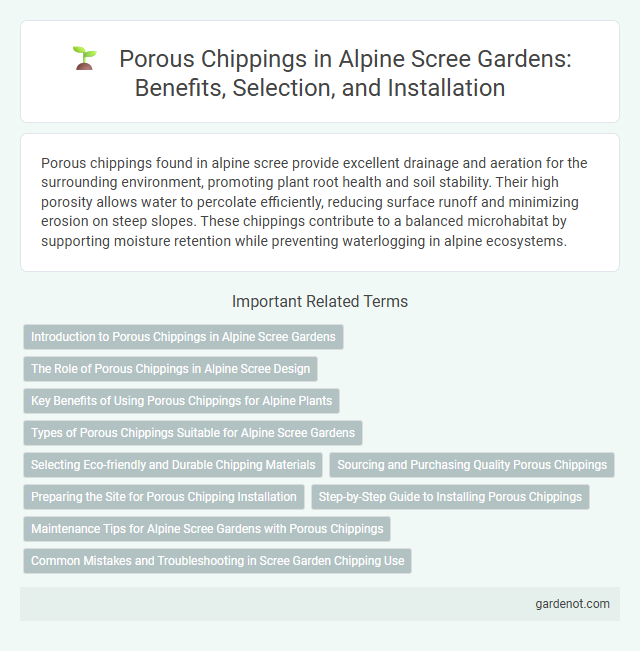Porous chippings found in alpine scree provide excellent drainage and aeration for the surrounding environment, promoting plant root health and soil stability. Their high porosity allows water to percolate efficiently, reducing surface runoff and minimizing erosion on steep slopes. These chippings contribute to a balanced microhabitat by supporting moisture retention while preventing waterlogging in alpine ecosystems.
Introduction to Porous Chippings in Alpine Scree Gardens
Porous chippings in alpine scree gardens provide excellent drainage essential for the roots of alpine plants, preventing waterlogging in harsh mountain conditions. These small, irregular stones create a breathable surface that mimics natural scree habitats, supporting plant health and growth. Their mineral composition also contributes to maintaining soil pH balance, crucial for sensitive alpine species.
The Role of Porous Chippings in Alpine Scree Design
Porous chippings play a crucial role in alpine scree design by facilitating efficient drainage and preventing water accumulation that can destabilize slopes. Their high permeability helps maintain soil aeration, promoting root growth and supporting alpine vegetation. These properties enhance slope stability and reduce erosion in harsh mountain environments.
Key Benefits of Using Porous Chippings for Alpine Plants
Porous chippings provide excellent drainage essential for alpine scree environments, preventing root rot and promoting healthy root development in alpine plants. Their lightweight and breathable structure helps maintain optimal moisture levels while allowing air circulation around plant roots, enhancing nutrient absorption. Using porous chippings also reduces soil compaction and supports natural mineral exchange, creating a stable and nutrient-rich growing medium tailored for alpine plant resilience.
Types of Porous Chippings Suitable for Alpine Scree Gardens
Porous chippings suitable for Alpine scree gardens include expanded shale, lava rock, and pumice due to their excellent drainage properties and lightweight structure. Expanded shale offers durability and aeration, while lava rock's irregular shape enhances soil oxygenation and moisture retention. Pumice provides high porosity and mineral content, promoting root health and preventing waterlogging in alpine conditions.
Selecting Eco-friendly and Durable Chipping Materials
Porous chippings in alpine scree environments must prioritize eco-friendly materials such as crushed volcanic rocks or recycled porous aggregates to support natural water drainage and minimize ecological impact. Durable options often include weather-resistant basalt or granite chippings that withstand freeze-thaw cycles common in high-altitude scree slopes. Selecting these materials enhances stability while preserving the delicate alpine ecosystem and promoting sustainable land management practices.
Sourcing and Purchasing Quality Porous Chippings
Sourcing quality porous chippings for alpine scree requires selecting materials with high permeability and durability to ensure effective drainage and long-term stability. Purchasing from reputable suppliers who provide certified, chemically inert stones, often composed of crushed granite or limestone, guarantees consistent particle size and porosity essential for optimal water flow. Verifying the geological origin and testing for contaminants minimizes risks of soil degradation and supports ecological sustainability in alpine environments.
Preparing the Site for Porous Chipping Installation
Preparing the site for porous chipping installation in alpine scree environments involves thorough ground leveling and ensuring proper drainage to prevent water accumulation. Soil compaction must be minimized to maintain permeability, with the removal of organic debris and fine particles that can clog the porous structure. Establishing a stable base layer with geotextile fabric enhances structural integrity and supports long-term performance of the porous chippings.
Step-by-Step Guide to Installing Porous Chippings
Porous chippings provide excellent drainage and reduce surface water runoff in alpine scree environments. Begin by preparing the site with proper excavation and grading to ensure a stable base, then lay a geotextile membrane to prevent weed growth and soil mixing. Finally, evenly spread the porous chippings to a recommended depth of 50-75mm, compacting gently to create a durable, permeable surface suitable for alpine conditions.
Maintenance Tips for Alpine Scree Gardens with Porous Chippings
Porous chippings enhance drainage in Alpine scree gardens, preventing waterlogging and root rot by allowing excess moisture to flow through. Regularly removing debris and organic buildup maintains the permeability of the chippings, promoting healthy plant growth in these rocky, well-drained environments. Applying a light rake or gentle wash helps preserve the texture and appearance of porous chippings, ensuring longevity and functional aesthetics in alpine garden maintenance.
Common Mistakes and Troubleshooting in Scree Garden Chipping Use
Porous chippings in alpine scree gardens often suffer from improper drainage, leading to water retention that can damage plant roots and reduce aeration. A common mistake is selecting non-porous or overly fine chippings, which inhibit water flow and promote algae growth. Regularly assessing the chipping size and ensuring appropriate layering helps maintain optimal permeability and prevents these issues.
Porous chippings Infographic

 gardenot.com
gardenot.com